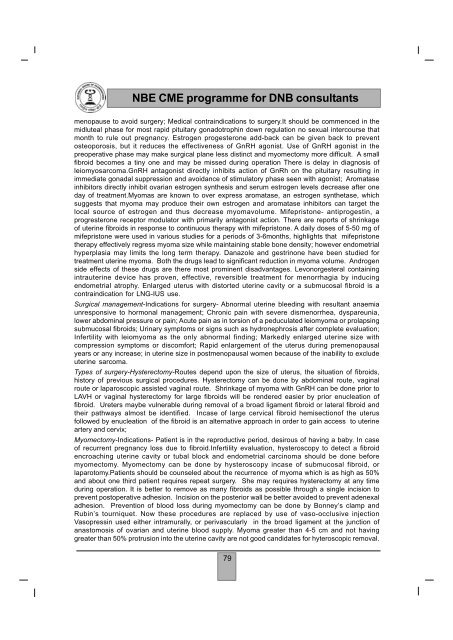NBE CME programme for DNB consultants - National Board Of ...
NBE CME programme for DNB consultants - National Board Of ...
NBE CME programme for DNB consultants - National Board Of ...
You also want an ePaper? Increase the reach of your titles
YUMPU automatically turns print PDFs into web optimized ePapers that Google loves.
<strong>NBE</strong> <strong>CME</strong> <strong>programme</strong> <strong>for</strong> <strong>DNB</strong> <strong>consultants</strong>menopause to avoid surgery; Medical contraindications to surgery.It should be commenced in themidluteal phase <strong>for</strong> most rapid pituitary gonadotrophin down regulation no sexual intercourse thatmonth to rule out pregnancy. Estrogen progesterone add-back can be given back to preventosteoporosis, but it reduces the effectiveness of GnRH agonist. Use of GnRH agonist in thepreoperative phase may make surgical plane less distinct and myomectomy more difficult. A smallfibroid becomes a tiny one and may be missed during operation There is delay in diagnosis ofleiomyosarcoma.GnRH antagonist directly inhibits action of GnRh on the pituitary resulting inimmediate gonadal suppression and avoidance of stimulatory phase seen with agonist; Aromataseinhibitors directly inhibit ovarian estrogen synthesis and serum estrogen levels decrease after oneday of treatment.Myomas are known to over express aromatase, an estrogen synthetase, whichsuggests that myoma may produce their own estrogen and aromatase inhibitors can target thelocal source of estrogen and thus decrease myomavolume. Mifepristone- antiprogestin, aprogresterone receptor modulator with primarily antagonist action. There are reports of shrinkageof uterine fibroids in response to continuous therapy with mifepristone. A daily doses of 5-50 mg ofmifepristone were used in various studies <strong>for</strong> a periods of 3-6months, highlights that mifepristonetherapy effectively regress myoma size while maintaining stable bone density; however endometrialhyperplasia may limits the long term therapy. Danazole and gestrinone have been studied <strong>for</strong>treatment uterine myoma. Both the drugs lead to significant reduction in myoma volume. Androgenside effects of these drugs are there most prominent disadvantages. Levonorgesteral containingintrauterine device has proven, effective, reversible treatment <strong>for</strong> menorrhagia by inducingendometrial atrophy. Enlarged uterus with distorted uterine cavity or a submucosal fibroid is acontraindication <strong>for</strong> LNG-IUS use.Surgical management-Indications <strong>for</strong> surgery- Abnormal uterine bleeding with resultant anaemiaunresponsive to hormonal management; Chronic pain with severe dismenorrhea, dyspareunia,lower abdominal pressure or pain; Acute pain as in torsion of a peduculated leiomyoma or prolapsingsubmucosal fibroids; Urinary symptoms or signs such as hydronephrosis after complete evaluation;Infertility with leiomyoma as the only abnormal finding; Markedly enlarged uterine size withcompression symptoms or discom<strong>for</strong>t; Rapid enlargement of the uterus during premenopausalyears or any increase; in uterine size in postmenopausal women because of the inability to excludeuterine sarcoma.Types of surgery-Hysterectomy-Routes depend upon the size of uterus, the situation of fibroids,history of previous surgical procedures. Hysterectomy can be done by abdominal route, vaginalroute or laparoscopic assisted vaginal route. Shrinkage of myoma with GnRH can be done prior toLAVH or vaginal hysterectomy <strong>for</strong> large fibroids will be rendered easier by prior enucleation offibroid. Ureters maybe vulnerable during removal of a broad ligament fibroid or lateral fibroid andtheir pathways almost be identified. Incase of large cervical fibroid hemisectionof the uterusfollowed by enucleation of the fibroid is an alternative approach in order to gain access to uterineartery and cervix;Myomectomy-Indications- Patient is in the reproductive period, desirous of having a baby. In caseof recurrent pregnancy loss due to fibroid.Infertility evaluation, hysteroscopy to detect a fibroidencroaching uterine cavity or tubal block and endometrial carcinoma should be done be<strong>for</strong>emyomectomy. Myomectomy can be done by hysteroscopy incase of submucosal fibroid, orlaparotomy.Patients should be counseled about the recurrence of myoma which is as high as 50%and about one third patient requires repeat surgery. She may requires hysterectomy at any timeduring operation. It is better to remove as many fibroids as possible through a single incision toprevent postoperative adhesion. Incision on the posterior wall be better avoided to prevent adenexaladhesion. Prevention of blood loss during myomectomy can be done by Bonney’s clamp andRubin’s tourniquet. Now these procedures are replaced by use of vaso-occlusive injectionVasopressin used either intramurally, or perivascularly in the broad ligament at the junction ofanastomosis of ovarian and uterine blood supply. Myoma greater than 4-5 cm and not havinggreater than 50% protrusion into the uterine cavity are not good candidates <strong>for</strong> hyteroscopic removal.79
















